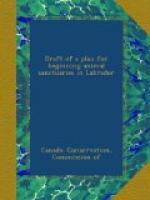The spring sealing of 1912 was a failure on the Canadian Labrador, as the main “harp” herd was missed by just one day. The whole industry is carried on by Newfoundlanders and men whose vessels take their catch to Newfoundland, because the only working plant is concentrated there. The excessive spring kill greatly depletes the females and young, as it takes place in the whelping season, when the herds are moving north along the off-shore ice; and this depletion naturally spoils not only the Newfoundlanders’ permanent industry itself but the much smaller inshore autumn catch by our own Canadian Labradorians, when the herds are moving south. The Canadians along the North Shore and Labrador look upon the invading Newfoundlanders, in this and other pursuits, very much as a farmer looks upon a gipsy whose horse comes grazing in his hayfield. And the analogy sometimes does hold good. When men under a different government, men who do not own a foot of land in Canada, men who do not pay specific taxes for Canadian rights, when these men slaughter seals on inshore ice, use land and inlets for cleaning fish and foul the water with their “gurry”, and when they also “egg” on other peoples’ islands in defiance of the law, then the analogy is perfect. It does not hold good, of course, in ordinary fishing, which is conducted under Dominion licence and vigilantly watched by Commander Wakeham. But whether Canada is not giving away too much for what she gets in licences is quite another question.
The excessive spring kill by the Newfoundlanders does not seem to be the only reason why the local seal hunt is not so good as it used to be. The whites complain that the Indians along the coast kill an undue number of seals on the one hand and of caribou on the other. But fishermen all the world over are against the harbour seals; and generally exaggerate their depredations, as they exaggerate the depredations of most kinds of seabirds. Whatever the fate of the harbour seals should be, there can be no doubt that the harps or Greenland seals, the bearded or square-flippers, the grey or horseheads, and the gigantic and magnificently game hoods, should all be put under conservation. I am also inclined to think that the walrus could be coaxed back to what once were some of his most favourite haunts. Just now he has no chance whatever; and he is so extremely rare that the one I nearly rowed the dinghy into last August, down at Whale Head East, was only the second seen inside the Straits during the present century.




